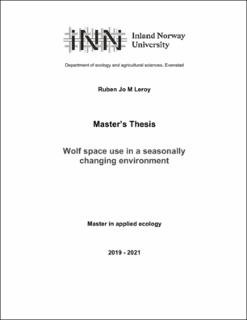| dc.description.abstract | In this study, we investigate the space use of a recolonizing predator in Scandinavia in relation
to the density of its main prey and other environmental variables. Animal space use is
influenced by intrinsic factors, such as age, sex and reproductive phase, presence of other
animals (e.g., mates, competitors, predators, prey) and habitats providing food, shelter or
disturbance. In heterogeneous landscapes, resources are often not evenly distributed which can
influence animal movement and behavior, as well as species interactions. For predators,
obtaining food resources is often challenging as prey tend to develop anti-predator strategies
and adaptations after predators settle in an environment. In addition, seasonal variation shifts
both the spatial and temporal resource availability, which in turn affects the space use of the
predator. Here, we study the space use of the Scandinavian wolf (Canis lupus) in relation to
its main prey, the moose (Alces Alces) to gain insight into which parameters lie at the cause.
We analyzed GPS locations of nine breeding wolves in five wolf territories and compared their
utilization distribution with the seasonally changing distribution of moose fecal pellet groups
and other habitat covariates. Contrary to our initial predictions, we found that moose pellet
group density was negatively correlated with wolf space use in summer, and that the
relationship between pellet group density and wolf space use was weak and its direction
unclear during in winter. The space use of wolves reflects multiple behavioral strategies of
predator and prey that may explain this pattern. Wolves selected transitional forest stands
(young forests) during both summer and winter. Additionally, wolves significantly avoided
areas with human infrastructures (buildings and roads) both in summer and winter. In
summary, the relationship between wolf space use, prey density and different habitat types
differed between seasons, although anthropogenic variables had a negative effect throughout
the year. Further research should differentiate between different behavioral states of the
wolves, such as resting, breeding, travelling and consuming prey. This would help to
understand the importance of seasonal shifts in prey distributions and different habitat types
and support the management and conservation of this protected, but conflict-prone species. | en_US |
